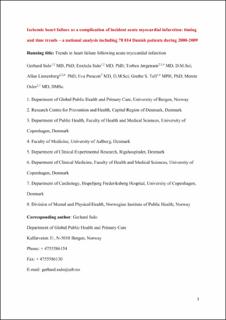| dc.description.abstract | Aim: Heart failure is a serious complication of acute myocardial infarction leading to poor prognosis. We aimed at exploring time trends of heart failure and their impact on mortality among patients with an incident acute myocardial infarction. Methods: From the National Patient Danish Registry we collected data on all patients hospitalized with an incident of acute myocardial infarction during 2000–2009 and identified cases with in-hospital heart failure (presented on admission or developing heart failure during acute myocardial infarction hospitalization) or post-discharge heart failure (a hospitalization or outpatient visit following acute myocardial infarction discharge), and assessed in-hospital, 30-day and 1-year mortality. Results: Of the 78,814 patients included in the study, 10,248 (13.0%) developed in-hospital heart failure. The odds of in-hospital heart failure declined 0.9% per year (odds ratio=0.991, 95% confidence interval: 0.983–0.999). In-hospital heart failure was associated with 13% (odds ratio=1.13, 95% confidence interval: 1.06–1.20) and 14% (odds ratio=1.14, 95% confidence interval: 1.07–1.20) higher in-hospital and 30-day mortality, respectively. Of the 61,637 patients discharged alive without in-hospital heart failure, 5978 (9.7%) experienced post-discharge heart failure, 4116 (6.7%) were hospitalized and 1862 (3.0%) were diagnosed at outpatient clinics. The risk of heart failure requiring hospitalization declined 5.5% per year (hazard ratio=0.945, 95% confidence interval: 0.934–0.955) whereas the risk of heart failure diagnosed at outpatient clinics increased 13.4% per year (hazard ratio=1.134, 95% confidence interval: 1.115–1.153). Post-discharge heart failure was associated with 239% (hazard ratio=3.39, 95% confidence interval: 3.18–3.63) higher 1-year mortality. Conclusions: In-hospital and post-discharge heart failure requiring hospitalization decreased whereas post-discharge heart failure diagnosed at outpatient clinics increased among incident acute myocardial infarction patients during 2000–2009. The development of heart failure, especially after acute myocardial infarction discharge, indicates a poor prognosis. | en_US |

